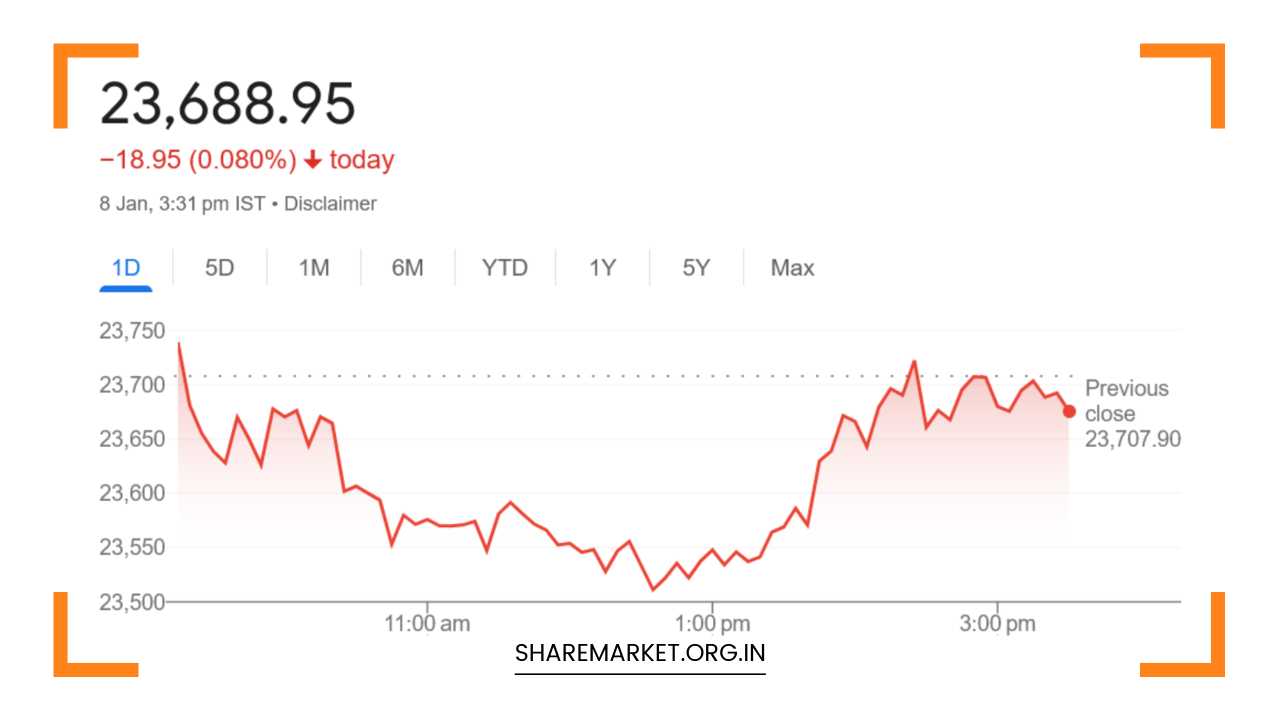Sensex Down 50 Points, Nifty at 23,688; Tomorrow Nifty Prediction

Tomorrow Nifty Prediction
Market Update: January 8 – Sensex and Nifty Close Flat Amid Volatility; Key Insights and Outlook for January 9
The Indian stock market closed on a mixed note on January 8, with the Sensex and Nifty ending slightly lower in a session marked by high volatility.
The market faced sharp swings during the day, initially dipping significantly before recovering toward the close, reflecting cautious sentiment among investors due to weak economic forecasts and growing uncertainty surrounding the upcoming third-quarter results.
The volatility in the market can also be attributed to global cues, such as rising US bond yields and a somewhat restrained outlook for rate cuts by the US Federal Reserve.
The day’s movements underscored a sense of caution ahead of key data releases and the Union Budget, which could provide a clearer picture of the government’s fiscal stance.
Market Overview: Sensex and Nifty Close Marginally Lower
On January 8, the Indian equity markets experienced sharp fluctuations, ending the day with only modest losses:
- Sensex closed at 78,148.49, down by 50.62 points or 0.06%.
- Nifty finished at 23,688.95, lower by 18.95 points or 0.08%.
Despite the losses, the session was marked by a strong recovery from early lows, indicating that underlying buying interest, particularly in blue-chip stocks, helped support the market.
A total of 1,336 stocks advanced, while 2,466 stocks declined, and 96 stocks remained unchanged, reflecting a broad-based selloff, particularly in mid and small-cap stocks.
Sectoral Performance: Divergence in Key Segments
The sector performance on January 8 showed a mixed picture, with some segments witnessing gains while others continued to underperform.
The BSE Midcap and Smallcap indices both saw declines of about 1%, mirroring the broad-based weakness in the market.
- Top Gaining Sectors:
- FMCG: Stocks in the FMCG sector, a defensive play in uncertain times, saw modest gains, with major companies benefiting from strong consumer demand.
- Oil & Gas: The oil and gas sector continued its positive momentum, supported by rising crude oil prices and a favorable domestic environment for these stocks.
- IT: The IT sector showed strength as global demand for technology services remained robust. Investors continued to bet on key players in this space, seeing them as stable performers amid global economic uncertainty.
- Telecom: Telecom stocks also gained, with investors reacting positively to regulatory developments and the steady growth outlook for the sector.
- Top Losing Sectors:
- Realty: Real estate stocks were under pressure, with concerns over slowing demand in the residential and commercial segments.
- PSU Banks: Public sector banks faced a sell-off as investor sentiment remained cautious regarding asset quality concerns and slow loan growth.
- Pharma: The pharmaceutical sector also came under pressure as concerns over pricing regulations and competition from generic drugmakers weighed on investor sentiment.
- Metals: Metal stocks, including key players in steel and aluminum, continued to face headwinds amid weaker global demand and concerns over potential slowdowns in key markets like China.
Notable Stock Movements
In terms of individual stock performances:
- Top Gainers:
- ONGC, ITC, Reliance Industries, Asian Paints, and Dr. Reddy’s Laboratories were some of the notable gainers on the Nifty index. These stocks benefitted from specific sectoral tailwinds and positive investor sentiment toward large-cap, established companies.
- Top Losers:
- Apollo Hospitals, Trent, Bajaj Auto, UltraTech Cement, and Shriram Finance saw significant losses, driven by both sector-specific headwinds and broader market sentiment. Apollo Hospitals, for instance, faced profit-taking after strong previous gains, while Trent and Bajaj Auto were impacted by concerns about demand slowdown.
Market Insights: Volatility Driven by Economic Concerns and External Factors
Vinod Nair, Research Head at Geojit Financial Services, attributed the volatility to several key factors, including the weak GDP estimates for India and heightened uncertainty surrounding the upcoming earnings season.
These factors have led to a more cautious stance among investors, particularly as they await fresh data to confirm or refute the economic slowdown narrative.
Further compounding the market’s nervousness was the rising US bond yields, which have been trending upwards in recent weeks.
Investors have been pricing in the possibility of slower interest rate cuts from the US Federal Reserve in 2025, which could limit the scope for global liquidity.
This has impacted global risk sentiment, and emerging markets like India have been particularly sensitive to these shifts.
Aditya Gaggar, Director at Progressive Shares, commented on the market’s movements, noting that the Nifty initially experienced a sharp decline, falling by more than 200 points, mainly driven by weaker-than-expected economic indicators, such as GDP growth projections.
However, the index found strong support around the 23,500 level, which led to a recovery as buyers stepped in, particularly in blue-chip stocks.
The Nifty’s resilience, despite initial weakness, suggests that there is underlying strength in the market, with investors viewing any dip as a potential buying opportunity, especially in stocks with strong fundamentals.
Technical Analysis: Key Levels and Pattern Formation
From a technical standpoint, Nifty formed a bullish hammer candlestick pattern, indicating a possible reversal of the previous downtrend.
The pattern typically suggests that, after an initial sell-off, there is buying interest at lower levels, which could signal a potential upward move.
The 23,500 level is now seen as an immediate support zone, providing a cushion for the market in the near term.
On the upside, the 23,800-23,900 range is likely to act as strong resistance. A break above this zone could signal further upside momentum, potentially paving the way for a more sustained recovery.
Prediction for January 9: Caution Amid Economic Uncertainty
As we head into January 9, the market is likely to remain volatile, driven by the uncertain global macroeconomic environment and expectations of weaker domestic economic data.
Investors will closely monitor developments related to the US Federal Reserve’s stance on interest rates, as any further clues about the global liquidity environment could have significant ramifications for emerging markets like India.
The market sentiment is expected to remain subdued in the near term, as investors remain wary of a slowdown in global growth, potential tightening of liquidity, and domestic concerns over GDP growth and corporate earnings.
However, the market is also poised for periodic recoveries, particularly in blue-chip stocks that are seen as safe havens in times of uncertainty.
In the near term, investors should keep an eye on key technical levels such as 23,500 (support) and 23,800-23,900 (resistance) for the Nifty.
Any breakthrough in these levels could signal a more definitive move in either direction, while the broader market sentiment will hinge on global cues and the unfolding of third-quarter earnings reports.
Final Remarks
In conclusion, the Indian stock market on January 8 displayed both caution and resilience, with the major indices ending marginally lower after a volatile trading session.
While short-term market sentiment remains weak, with global factors such as rising US bond yields and expectations of subdued US rate cuts weighing on investor sentiment, there is also room for optimism.
The government’s fiscal policies, particularly in the upcoming Union Budget, could provide crucial support for economic revival.
Investors should stay alert to these developments and focus on key support and resistance levels to navigate the ongoing volatility.

















